-
February 26, 2020 by Total Fire and Safety

Restaurant fires destroy more than property. Restaurants hold priceless memories of celebrations and firsts, meetings with important people, backgrounds for special announcements or the reliable spot to pick up favorite weekday takeout meals. With a fire, they all go up in smoke—literally. Restaurant fires can be devastating, not only to the owners and patrons, but to the employees as well.
Nearly 8,000 restaurant fires occur each year resulting in $165 million in property damage. According to the NFPA, cooking equipment was the leading cause of restaurant fires (61%), electrical equipment (9%), heating equipment (9%), and smoking materials (7%). What’s the best way to protect your restaurant from a fire? Understand the dangers and prevention measures you can take to skirt disaster in your dining or takeout establishment.
DANGER:
Exhaust Systems and Ductwork
The vents and fans behind ovens and stoves accumulate a buildup of grease. Since the vents and fans extract flammable vapors, a spark can light grease buildup. Oven hoods above stoves, can also harbor flammable vapors from contaminated cooking air. This can feed through the exhaust system and cause a fire hazard. Also included in these systems are grease traps. Most commercial kitchens are required to maintain a grease trap preventing oils and fats from clogging sewers.
PREVENTION
- Clean all areas daily
- Twice a year, have a thorough hood cleaning by professionals
- Clean grease traps monthly, quarterly, or yearly as mandated by the NFPA
DANGER:
Gas Leaks
Gas leaks are the most catastrophic cause of restaurant fires because they cause an explosion. Gas leaks occur when faulty equipment is unable to support the flow of gas and leaks flammable gas in the air. A simple electrical device can ignite the gas and lead to an explosion.
PREVENTION
- Be alert and detect the signs of a gas leak (gas smell, orange/yellow flames, extinguished pilot lights)
- Perform equipment inspections daily and replacement of worn out equipment
DANGER:
Electrical Problems
Heat from unsafe or poor wiring in switches, sockets, or plugs can spark flammable or combustible materials. Overloading outlets, outdated wiring, and overpowering kitchen equipment can lead to a fire or even explosion.
PREVENTION
- Use only commercial equipment that is up-to-code
- Update wiring that can handle a busy kitchen
In the unfortunate event a restaurant fire occurs, a fire suppression system is your best protection. A restaurant fire suppression system is designed to provide fire protection for restaurant cooking appliances, exhaust hoods, and ducts. A fire suppression system detects fires through heat sensors, often before the kitchen staff does. When automatically discharged, the fire can be suppressed at its earliest stages. The result is minimal damage to the kitchen and minimal equipment down time.
Keep your restaurant kitchen safe from fires by properly installing and maintaining a working fire suppression system and empowering employees with fire safety and response training. It can mean the difference between a localized fire and a major blaze.
If you’re ready to safeguard your kitchen from a restaurant fire, Total Fire and Safety can test, service, and install fire suppression systems. TFS also provides first aid and fire extinguisher training on-site. Give us a call today and let our professionals provide “total” assurance your restaurant is protected from fire. Call us at 630.960.5060.
Category: Business Safety, Fire Equipment Inspections, Suppression system, Total Fire and Safety Tags: commercial fire protection, commercial fire safety, commercial fire suppression, fire and safety equipment, fire and safety needs, fire supression system, Total Fire & Safety | Comments Off on The Dangers and Prevention of Restaurant Fires
-
December 23, 2019 by Total Fire and Safety

We wish you the warmth and cheer of the season!
Thank you for your continued support throughout the year.
From all of us at Total Fire & Safety
Twelve Days of Fire Safety
On the first day of safety, Total Fire gave to me…
A safe and code compliant facility!
On the second day of safety, Total Fire gave to me…
Two emergency plans
and a safe and code compliant facility!
On the third day of safety, Total Fire gave to me…
Three eyewash stations
Two emergency plans
and a safe and code compliant facility!
On the fourth day of safety, Total Fire gave to me..
Four first aid kits
Three eyewash stations
Two emergency plans
and a safe and code compliant facility!
On the fifth day of safety, Total Fire gave to me…
FIVE WIRELESS ALARMS
Four first aid kits
Three eyewash stations
Two emergency plans
and a safe and code compliant facility!
On the sixth day of safety, Total Fire gave to me…
Six extinguishers inspected
FIVE WIRELESS ALARMS
Four first aid kits
Three eyewash stations
Two emergency plans
and a safe and code compliant facility!
On the seventh day of safety, Total Fire gave to me…
Seven exit signs Six extinguishers inspected
FIVE WIRELESS ALARMS
Four first aid kits
Three eyewash stations
Two emergency plans
and a safe and code compliant facility!
On the eight day of safety, Total Fire gave to me…
Eight backflow inspections
Seven exit signs
Six extinguishers inspected
FIVE WIRELESS ALARMS
Four first aid kits
Three eyewash stations
Two emergency plans
and a safe and code compliant facility!
On the ninth day of safety, Total Fire gave to me…
Nine sprinkler systems
Eight backflow inspections
Seven exit signs
Six extinguishers inspected
FIVE WIRELESS ALARMS
Four first aid kits
Three eyewash stations
Two emergency plans
and a safe and code compliant facility!
On the tenth day of safety, Total Fire gave to me…
Ten safety trainings
Nine sprinkler systems
Eight backflow inspections
Seven exit signs
Six extinguishers inspected
FIVE WIRELESS ALARMS
Four first aid kits
Three eyewash stations
Two emergency plans
and a safe and code compliant facility!
On the eleventh day of safety, Total Fire gave to me…
Eleven fire pumps serviced
Ten safety trainings
Nine sprinkler systems
Eight backflow inspections
Seven exit signs
Six extinguishers inspected
FIVE WIRELESS ALARMS
Four first aid kits
Three eyewash stations
Two emergency plans
and a safe and code compliant facility!
On the twelfth day of safety, Total Fire gave to me…
Twelve new extinguishers
Eleven fire pumps serviced
Ten safety trainings
Nine sprinkler systems
Eight backflow inspections
Seven exit signs
Six extinguishers inspected
FIVE WIRELESS ALARMS
Four first aid kits
Three eyewash stations
Two emergency plans
and a safe and code compliant facility!
Category: Fire Alarm Monitoring, Fire Equipment Inspections, Fire exits, Fire Extinguishers, Fire News, Fire Safety, Sprinkler Systems, Total Fire and Safety, Uncategorized Tags: commercial fire safety, fire and safety equipment, fire and safety solutions, Fire Extinguisher, fire safety, Total Fire & Safety, wireless fire alarms | Comments Off on Happy Holidays from Total Fire & Safety
-
November 12, 2019 by Total Fire and Safety
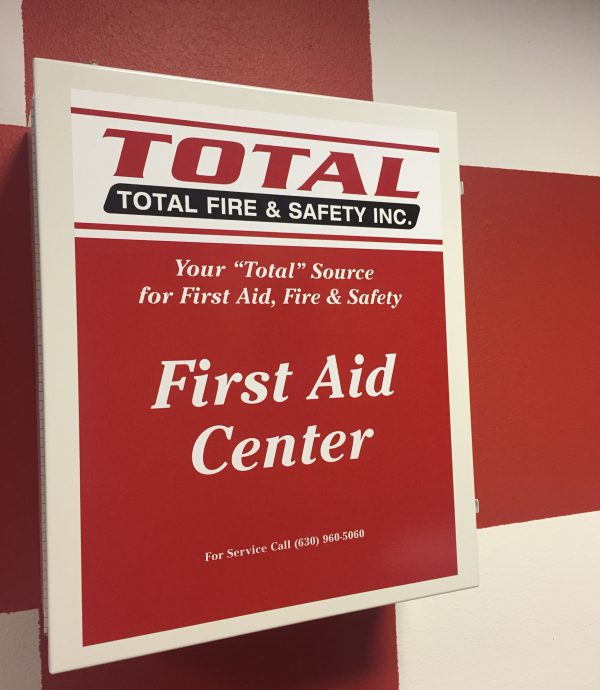
Does your organization have a first aid kit hanging on the wall? It sits there silently like a dutiful soldier, ready and waiting for any emergency. But with winter on its way, you may be surprised at how often that first aid kit can be called into service during the coldest months of the year.
Winter weather can easily compromise employee safety, whether the workplace is outdoors or in an office. It is important to keep first aid kits well stocked with winter safety essentials. Before you start planning your holiday office party, let’s look at your first aid kit and what we can do to “winterize” it.
OSHA has established a list of required first aid supplies for the workplace. Depending on the business and specifics of the environment, there are different first aid requirements. Employers are responsible for keeping the first aid kit stocked and up to date with the necessary supplies needed. They include:
- Band-aids, Elastic Bandages/Adhesive Tape, Sterile Gauze Pads/Rolls and Large Pressure Bandages in different shapes and sizes of bandages for possible falls, cuts, and scrapes. The opening of cracked, chapped winter skin can precipitate the need for a band-aid or a fall on the ice can merit more serious first aid treatment.
- Non-Latex Gloves, Antiseptic wipes, Peroxide and Alcohol and Triple Antibiotic Ointment will help keep those helping tend a wound safe, and also help the wound heal more quickly. Protect skin from contamination.
- Eye Pads and Eye Wash can help tend weather-related discomforts on the way into work.
- Tongue Depressors can be used to check throat irritations during winter flu season or be used as splints for possible weather-related injuries.
- CPR Shields can protect users from bodily fluids when CPR is essential. In winter, shoveling and overexertion in the cold can lead to cardiac arrest and the need for onsite CPR. Total Fire & Safety can help with employee training in this area.
- Triangular Bandages can be onsite in the event of the need for a sling or tourniquet. Falls on ice or minor accidents may require such dressings.
- Cold Packs: Instant cold packs help with sprains, fractures, burns, etc.… common injuries associated with falls, accidents, or overheating.
- Thermometer: Determines body temperatures. The flu and other winter maladies can be contagious! Detecting an above normal temperature in an employee can prevent an outbreak that can take down a workplace.
- Aspirin, Tylenol, or Motrin can help alleviate the symptoms of a cold.
- Penlight can be used to look in ears and throats for maladies, or even pupils for possible concussion victims.
- Antihistamine Tablets and Hydrocortisone to quell the allergies and dermatitis from the dry air, increased dust, and lack of fresh air during the winter months.
- Blankets to use in emergencies, such as frostbite, hypothermia, etc.
For any company, the first aid kit can be your first offense against the common winter injuries that employees can suffer en route or while at work:
Sprains and Broken Bones
Ice covered roadways, sidewalks, parking lots, and driveways put you at risk for a nasty fall which can result in a sprain or broken bone. If the injury is minor and does not require an immediate doctor’s care, delve into your first aid kit and treat the injury with RICE:
1. Rest the injured limb with crutches, a sling, or splint, or anything you can to keep from putting stress on it.
2. Ice the injured limb. Apply a cold pack to the area to prevent swelling.
3. Compress the injury by wrapping a bandage around it or use a sleeve.
4. Elevate the injured limb above the heart to reduce swelling.
In addition, offer the victim Tylenol, Aspirin, or Motrin for pain and swelling.
Frostbite
Frostbite occurs when skin cells and tissues freeze, damaging the skin walls. Most often it happens to fingers, toes, noses, cheeks, chin, ears, and the areas with most exposed skin. If frost bite should happen, remove the victim from the cold. Warm their hands by tucking them under the armpits. Cover the nose, ears, and face and remove any wet clothing. Once in warm shelter, place frostbitten areas under warm, not hot, water. Avoid direct heat. Treat pain with Tylenol, Aspirin, or Motrin from your first aid kit. If blisters or numbness continues, seek medical attention.
Hypothermia
Hypothermia happens when the body’s internal temperature drops below 95 degrees. Call 911 immediately. A person’s breath can become shallow or they can stop breathing all together. If this happens, CPR must be administered using a CPR shield from your first aid kit. If CPR is not necessary, get the person away from the cold and wrap them in a blanket, also in your first aid kit. Apply a warm compress to the chest, neck, groin, and head.
Winter weather can be dangerous and serious injuries can occur, beyond what a first aid kit is capable to handle. Assess the situation and call 911, if needed, first.
Total Fire and Safety can help you keep your first aid kits stocked appropriately and provide on-site first aid training for employees. Be prepared for winter! Give us a call today! (630)960-5060.
Category: Business Safety Tags: commercial fire protection, commercial fire safety, fire and safety solutions, first aid, first aid supplies, Total Fire & Safety | Comments Off on Fighting Winter Ills with the Company First Aid Kit
-
April 24, 2019 by Total Fire and Safety
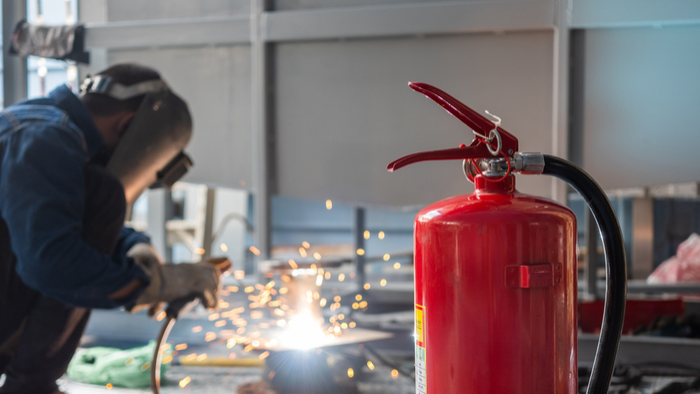
According to the National Fire Protection Agency (NFPA), between 2011 and 2015, there was an estimated 37,910 fires at industrial properties each year. These industrial fires resulted in 16 civilian deaths, 273 civilian injuries, and $1.2 billion in property damage.
Industrial fires are serious, but there are several things you can do at your plant or factory to minimize the possibility of an industrial fire. First, it’s important to know how they usually start.
The five most common causes of industrial fires are…
1. Combustible Dust Fires
A combustible dust is any dust or fine material that has the potential to catch fire and explode when it is mixed in the air. Many times, materials that are normally considered non-flammable can act as a combustible when fine particles are mixed with air in a particular concentration. Combustible dust happens in two waves. A primary explosion causes particles to become airborne, and then the dust cloud can ignite and cause a secondary explosion, much more severe than the first. Combustible dust can bring down entire facilities.
How do I Prevent Combustible Dust Fires?
- Implement a hazardous dust inspection, testing, housekeeping, and control program.
- Regularly inspect for dust residues in open and hidden areas.
- Use proper dust collection systems.
- If ignition sources are present, use cleaning methods that do not generate dust clouds.
- Control smoking, open flames, and sparks (mechanical and friction).
2. Hot Work Fires
Hot work is any activity that involves open flames or generates sparks or heat. This includes welding, heat treating, grinding, thawing pipes, torch cutting, brazing, soldering, etc. Hot work becomes a fire hazard when sparks and molten material travel…often as far as 35 feet, sometimes igniting combustible dust in other areas.
How do I Prevent Hot Work Fires?
- Train personnel on the hazards associated with hot work and make sure they are using proper safety equipment.
- Clear area of flammable materials including dust, gases, and liquids.
- Make sure a safety professional is on site to provide supervision of the work.
- Avoid hot work if possible.
3. Flammable Liquid and Gas Fires
These are most common in chemical plants. Flammable liquids and gases can ignite off sparks from the previous hazards or add fuel to an already burning fire.
How Do I Prevent A Flammable Gas Fire?
- Know the hazards of each flammable liquid and gas on-site. Read and follow the safety information for storage and follow the material safety data sheet included with the product.
- Properly store hazardous materials according to OSHA.
- Keep ignition sources away from flammable gases and liquids.
- Provide personal protective equipment, like gloves, bodysuits, vests, goggles, shoes etc.
4. Equipment and Machinery Fires
Equipment not properly installed, maintained, or operated correctly is a major cause of industrial fires. This is especially true for equipment associated with hot work and heating. Even machinery not seen as a fire hazard can become a risk with lack of proper maintenance.
How Do I Prevent Equipment and Machinery Fires?
- Training can help employers and employees identify possible risks and what to do if they find one.
- Keep the machines, equipment, and areas surrounding them, clean.
- Prevent machine overheating by following the manufacturer’s guidelines for recommended maintenance procedures.
5. Electrical Hazard Fires
Electrical fires are most common in manufacturing plants and include wiring that is exposed or not up to code, overloaded outlets, extension cords, overloaded circuits, static discharge, etc. A spark from electrical hazards can cause ignition of combustible dust and flammable liquids and gases.
How Do I Prevent Electrical Hazard Fires?
- Don’t overload electrical equipment or circuits.
- Unplug temporary equipment not in use.
- Avoid using extension cords.
- Use antistatic equipment as advised by OSHA and NFPA.
- Follow a regular cleaning schedule to ensure combustible dust and other hazardous materials are removed from areas that house equipment and machinery.
It can seem overwhelming to have to safeguard your facility against industrial fire hazards, but the pros at Total Fire and Safety can help you identify and prevent risks throughout your facility. They also provide fire safety training to educate employees on proper fire safety equipment operation and life safety procedures.
To take the first step in keeping industrial fires at bay at your facility, call Total Fire and Safety at 630-960-5060 or reach us at our 24/7 emergency line, 630-546-8909.
Category: Business Safety, Fire Safety, NFPA Compliance Tags: commercial fire protection, commercial fire safety, fire and safety solutions, fire safety training, Industrial Fire Prevention, Industrial Fire Safety, Total Fire & Safety | Comments Off on The Best Way to Prevent Industrial Fires
-
January 23, 2019 by Total Fire and Safety

Commercial first aid kits don’t have to be costly. Yet, when you start to compare commercial first aid providers, you will see some radical differences in pricing. Many first aid service companies find creative ways to drive up costs for their customers. At Total Fire & Safety, our customers never have to worry about “hidden costs” because there are none! Knowing what your company needs and being sure you are not paying for more can help your overall first aid budget and ensure you have the right first aid provider on your side. Here are some tips on hidden fees so you can avoid any surprise charges from your first aid service company.
- Make sure you know what is going in the box.
It is possible that you don’t need many of the supplies the service stocks in your cabinet. Depending on your workplace, employees can experience minor cuts etc. However, overstuffing a kit with odd size bandages and unnecessary items like hand lotion, lip ointment, dental cream, etc. helps a company justify a higher invoice. At Total Fire and Safety we stock what is required by OSHA and what is directed by the client. No redundant or unnecessary items.
- Make sure you are not getting charged extra for “normal” items.
Some companies charge extra for special items, like disinfectant wipes. Check your invoices! There are no surprises with TFS.
- Make sure you are not getting charged for additional representatives.
Some first aid companies have separate reps for stations, for example, first aid kits and eyewash stations. At TFS, your single representative is knowledgeable about all your first aid needs to streamline costs and deliver consistent quality service.
- Make sure the first aid service meets ANSI requirements.
ANSI (American National Standards Institute) puts together the requirements for first aid supplies in the workplace. They provide a specific list for first aid kits. A service company might overlook this list in order to stock a kit with many unnecessary various types of items. At Total Fire and Safety, we provide supplies required by ANSI as well as OSHA.
- Make sure you understand the fees on the invoice.
Do you see service or delivery charges, overstocking or restocking fees? First aid service companies pile these costs into an unreadable invoice. TFS does not charge service fees, fuel, or delivery charges. We only charge for items that employees have used. Have a question about the bill? TFS is there to answer any concerns.
There are many services companies in business to make a buck at the expense and well-being of your company. You should not have to choose between a safe work environment and a cheaper bill. TFS recognizes the importance of a healthy workplace combined with the affordability of superior service. TFS never overcharges, overstuffs, or places hidden fees with in a first aid kit. We provide the right supplies to keep employees safe at work while always keeping costs down. For more than 30 years, Total Fire and Safety has been providing OSHA approved first aid kits and replenishment to businesses. If we can help with your first aid needs, contact us today at 630-960-5060.
Category: Business Safety, First Aid, First Aid Kits, Total Fire and Safety Tags: fire and safety needs, fire safety, first aid, first aid supplies, Total Fire & Safety | Comments Off on Avoiding the Hidden Costs of Commercial First Aid Kits
-
October 2, 2018 by Total Fire and Safety
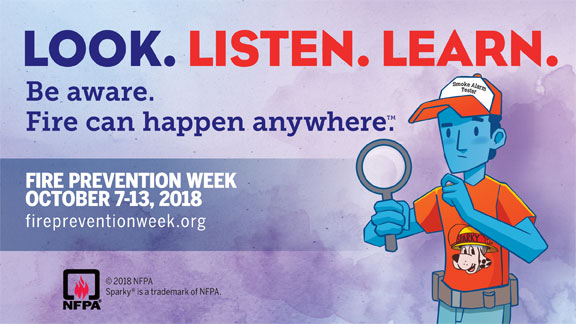
Fire prevention week was instituted in commemoration of the Great Chicago Fire of 1871 which burned from October 8-10, 1871 and took the lives of nearly 300 people. It burned nearly 3.3 square miles of Chicago and left over 100,000 residents homeless.
Forty years after the tragic blaze, the U.S. Fire Marshall used the anniversary to promote fire prevention and fire safety. In 1925, President Calvin Coolidge proclaimed fire prevention week as a national observance and it has become the longest running health observance in the country.
Even though we know more now about fire prevention than ever before and we have better equipment too, the National Fire Prevention Association (NFPA) released a shocking statistic: if you reported a fire in your home, you are more likely to die today than you were a few decades ago. Today’s home fires burn faster, allowing occupants less than two minutes to escape without harm.
Although the messages of Fire Prevention Week primarily focus on home fires, their messages can be applied at any location including businesses, warehouses, and other commercial spaces. Fire prevention week is a time to draw attention to the fire safety practices within your company using the resources provided by fire departments, the NFPA, and companies like Total Fire and Safety.
The following are some initiatives companies can take to observe Fire Prevention Week:
This year, fire prevention week runs October 7-13. The theme is Look. Listen. Learn. Be aware- Fire can happen anywhere. This year’s campaign focuses on basic but essential ways to escape your home fire safely with three simple steps:
- Look for places a fire could begin. Identify potential fire hazards in your workplace and remove them.
- Listen for the sound of the alarm. As soon as the alarm sounds, make your way out of the building at a safe distance from the fire.
- Learn two ways out of every room. Make sure all exits leading outside are free of clutter, unlocked and have emergency lights if necessary.
Fire prevention week is also commemorated at fire stations all over the area with special open houses and related programs. Here’s a roundup of some of the events in the Total Fire & Safety service area. For more information, see the website for each individual fire department.
If we can ever be of help to you during fire prevention week or any other time during the year, call Total Fire and Safety to ensure your business in in NFPA compliance with all of your commercial fire protection at 630-960-5060.
Saturday, Oct. 6
- Tinley Park Fire Department: 17355 68th Court, Tinley Park, 9 a.m. – 1 p.m.
- Schaumburg Fire Department: 950 W. Schaumburg Road, Schaumburg, 11 a.m. – 2p.m.
- Clarendon Hills Fire Department: 316 Park Ave., Clarendon Hills, 11 a.m. – 2 p.m.
- Minooka Fire Department: 7901 E. Minooka Road, Minooka, 11 a.m. – 2 p.m.
- Hazel Crest Fire Department: 2903 W. 175th St., Hazel Crest, 9 a.m. – 12 p.m.
- Bensenville Fire Protection District: 500 S. York Road, Bensenville, 12 – 3 p.m.
- Darien-Woodridge Fire Department: 7550 Lyman Ave., Darien, 10 a.m. – 1 p.m.
Sunday, Oct. 7
- Belvidere Fire Department: 123 S. State St., Belvidere, 1 – 4 p.m.
- Evanston Fire Department: 1817 Washington St., Evanston, 11 a.m. – 3 p.m.• West Chicago Fire Department: 200 Freemont St., West Chicago, 10 a.m. – 2 p.m.
- Cissna Park Fire Department: 206 N. 2nd St., Cissna Park, 11 a.m. – 5 p.m.
- Lake Zurich Fire Department: 321 S. Buesching Road, Lake Zurich, 11 a.m. – 2 p.m.
- Mokena Fire Department: 19853 S. Wolf Road, Mokena, 7:30 a.m. – 12 p.m.
- Peotone Fire Protection District: 7550 W. Joliet Road, Peotone, 11 a.m. – 3 p.m.
Monday, Oct. 8
- Western Springs Fire Department: 4353 Wolf Road, Western Springs, 6 – 8:30 p.m.
Wednesday, Oct. 10
- Downers Grove Fire Department: 6701 Main St., Downers Grove, 6:30 – 8:30 p.m.
Friday, Oct. 12
- Crete Fire Department: 524 W. Exchange St., Crete, 5 – 8 p.m.
- Beecher Fire Department: 711 Penfield St., Beecher, 5:30 – 8:30 p.m.
Saturday, Oct. 13
- Charles Fire Department: 112 N. Riverside Drive, St. Charles, 12 – 3 p.m.
- Harlem Roscoe Fire Protection District: 10544 Main St., Roscoe, 11 a.m. – 3 p.m.
- Schiller Park Fire Department: 9526 Irving Park Road, Schiller Park, 11 a.m. – 2 p.m.
- Northbrook Fire Department: 1840 Shermer Road, Northbrook, 9 a.m. – 12 p.m.
- Crystal Lake Fire Rescue Department: 100 W. Woodstock St., Crystal Lake, 11 a.m. – 2 p.m.
- Glen Ellyn Fire Department: 524 Pennsylvania Ave., Glen Ellyn, 10 a.m. – 1 p.m.
- Channahon Fire Department: 24929 Center St., Channahon, 11 a.m. – 2 p.m.
- Elk Grove Village Fire Department: 101 Biesterfield Road, Elk Grove Village, 12 – 3 p.m.
- Rolling Meadows Fire Department: 2455 Plum Grove Road, Rolling Meadows, 10 a.m. – 2 p.m.
- Lemont Fire Protection District: 15900 New Ave., Lemont, 11 a.m. – 2 p.m.
- River Forest Fire Department: 400 Park Ave., River Forest, 10 a.m. – 2 p.m.
- Northlake Fire Department: 118 E. Parkview Drive, Northlake, 12 – 3 p.m.
- Elgin Fire Department: 650 Big Timber Road, Elgin, 10 a.m. – 3 p.m.
- Prospect Heights Fire Protection District: 10 E. Camp McDonald Road, Prospect Heights, 10 a.m. – 2 p.m.
Sunday, Oct. 14
- Byron Fire Department: 123 N. Franklin St., Byron, 11 a.m. – 3 p.m.
- Manteno Fire Department: 13 S. Walnut St., Manteno, 12 – 3 p.m.
- Elmhurst Fire Department: 601 S. York St., Elmhurst, 12 – 4 p.m.
- North Palos Fire Protection District: 10629 S. Roberts Road, Palos Hills, 7 a.m. – 12 p.m.
- McHenry Township Fire Protection District: 3710 Johnsburg Road, Jonhsburg, 10 a.m. – 1 p.m.
Monday, Oct.15
Romeoville FPD Open House
Saturday, Oct. 20
- Dolton Fire Department: 14022 Park Ave., Dolton 10 a.m. – 3 p.m.
- La Grange Park Fire Department: 447 N. Catherine Ave., La Grange Park, 10 a.m. – 1 p.m.
- Hoffman Estates Fire Department: 225 Flagstaff Lane, Hoffman Estates, 1 – 4 p.m.
- Sycamore Fire Department: 2100 Frantum Road, Sycamore, 11 a.m. – 2 p.m.
Sunday, Oct. 21
- Grayslake Fire Department: 160 Hawley St., Grayslake, 7 a.m. – 12:30 p.m
Total Fire and Safety has a dedicated team of professionals that use the best technology to test and inspect fire safety equipment in any commercial building. TFS also provides training classes to educate employees both in the classroom and on-site. Knowledge is power and the more your employees know, the better they can protect themselves. What better time to spread the word than fire prevention week! If we can help you with your fire prevention in October or anytime, give Total Fire and Safety a call at 630-960-5060.
Category: Fire Extinguishers, Fire Extinguishers, Fire Safety, Sprinkler Systems, Total Fire and Safety Tags: fire and safety equipment, fire and safety needs, fire and safety solutions, Fire Extinguisher, lifesafety, Total Fire & Safety, Total Fire and Safety, training | Comments Off on Are Your Employees Ready for Fire Prevention Week?
-
August 23, 2018 by Total Fire and Safety
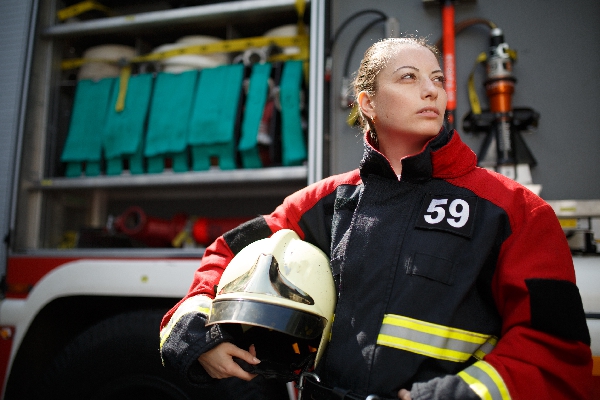
Are there more women firefighters in our future? YES! Groups of Suburban Chicago young women are proving it. This past summer a local Fire Protection District hosted a Girls Firefighter Summer Camp which was enthusiastically attended by many girls who are considering firefighting as a career. The girls learned all aspects of firefighting through hands-on training, like climbing ladders, treating patients, and putting out fires, etc. The goal of the camp was to show girls they can do the job, but they need look no further than the past and the present for their role models and inspiration.
Women Firefighters in History
Women have been firefighters for over 200 years which is an amazing fact in an industry so dominated by males.
- Molly Williams was the first woman firefighter. She was a slave in New York City until she became a member of Oceanus Engine Company #11 in 1815. Although she was as tough as the men, she always wore a calico dress and checkered apron to the fires.
- In 1820, Marina Betts joined the Pittsburgh fire department, a career that lasted 10 years.
- During WWII, two military fire departments in Illinois were staffed entirely by women volunteers.
- Lauren Howard was the first career female firefighter in Chicago. She joined the force in 1980 and was the only woman until 1986.
Women Firefighters Today
According to NFPA (National Fire Protection Association), 252,000 women work in the firefighting industry, but nationwide, only 4% of firefighters are women, a staggering number when compared to the 90% of women nurses and 97.5% of women teachers. In fact, females in farming and construction have a higher percent than female firefighters.
The International Fire Chief’s Association started a council for women fire chiefs in 2017 to network, share ideas and identify strategies to improve their organization. The council of 16 represented approximately 50 female fire chiefs across the country.
Even for the strongest female, the road to firefighting is not easy. Cities like Joliet, Illinois are hiring their first female recruit this year in their long, century old history. Another department in East Point, Georgia recently made headlines by hiring the first ever African-American female fire chief in the United States.
Male and Female Qualities
Let’s face it. When someone’s house is burning, most people don’t care if it’s a man or woman who shows up to help…they just want a good firefighter. And the attributes of a good firefighter are numerous and have nothing to do with gender.
- Honest and dependable
- Learns quickly; can remember and use their training when the pressure is on
- Physically fit; is committed to a healthy lifestyle and to maintaining fitness
- Functions well as part of a team
- Cares about and respects co-workers and members of the community
- Communicates and listens well
- Is dedicated to her/his work
- Has, and uses, common sense
- Is emotionally stable and deals with stress appropriately
- Has a sense of humor
- Is open-minded and flexible, willing to try new things and listen to new ideas
At Total Fire & Safety, we believe our work in inspection, installation and maintenance of fire safety equipment helps keep firefighters safe by helping minimize fire damage and providing what’s needed to fight fires until the force arrives. We salute all fire fighters and especially the brave women of the force who work to keep us safe!
Category: Fire News, Total Fire and Safety Tags: fire safety, fire safety in the news, Total Fire & Safety, Women Firefighters | Comments Off on Are There More Women Firefighters in Our Future?
-
May 30, 2018 by Total Fire and Safety
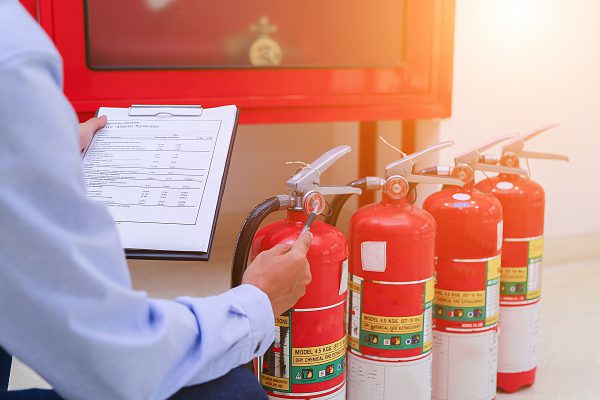
Most companies understand the mandate to have regular fire extinguisher inspections but many wonder why on earth a company could actually fail these inspections. After all, a fire extinguisher is rarely used so how can it need service?
Chances are you see a fire extinguisher every day, but how closely do you look at it? Even one dent in the tank can change the outcome. According to the NFPA, nearly 30 percent of fire extinguishers are not in proper working order. Total Fire and Safety’s twelve-point check can ensure your company’s compliance. However, there are five main reasons why companies fail a fire extinguisher inspection.
1. Unseen Damage– Corrosion or damage can occur over time in hard to see areas of the extinguisher, for example, rust within the tank. That is when a professional steps in and inspects the extinguisher inside and out. TFS will visually examine the extinguisher making sure it is free of dents, rust, or other hazards.
2. Potential Hose Blockage– Debris can clog the hose or deterioration of the O-rings can occur over time, rendering a fire extinguisher useless in an emergency. TFS will remove the hose completely to check for irregularities.
3. Possible Leaks– Whether large or small, a leak will cause the fire extinguisher to be inoperable. Anyone can check the pressure gauge to determine if there is a leak. However, if there is no pressure gauge, you will need a professional. TFS will confirm the compression in the tank.
4. Wear/Fading of Labels– Labels are vital when fighting a fire because they contain instructions on how to use the extinguisher. They also provide important information about the device’s maintenance history, which is needed by inspection professionals. Once your fire extinguisher inspection is complete, the labels will be updated, and an additional certification tag will be attached.
5. Recharging Needed– Once a fire extinguisher is used, even partially, it will need to be recharged immediately. If you fail to recharge the extinguisher, it will fail you in a fire.
Although these are common reasons companies fail fire extinguisher inspections, there are other possible hazards not listed. It is important to stay up-to-date with your fire extinguisher inspections. The NFPA requires inspection every month and maintenance every year by a professional. In addition, a stored pressure extinguisher requires internal maintenance every six years and a hydrostatic test every 12 years.
It takes a minute for a fire to spread and cause irreparable damage to your company—the same amount of time it takes to schedule a fire extinguisher inspection!
Total Fire and Safety can inspect your fire extinguishers to ensure they are unfailingly ready to fight fire at a moment’s notice. We also provide onsite training for your employees, including hands-on practice in the use of a fire extinguisher. Give us a call today at 630.960.5060.
Category: Business Safety, Fire code violation, Fire Equipment Inspections, Fire Extinguishers, Fire Extinguishers, Fire Safety, NFPA Compliance, Total Fire and Safety Tags: equipment, Extinguisher, fire and safety equipment, fire and safety needs, Fire Extinguisher, fire extinguisher inspections, fire safety, safety, Total Fire & Safety, Total Fire and Safety | Comments Off on Why Companies Fail Fire Extinguisher Inspections
-
March 21, 2018 by admin
Join us for the 2018 Fire Safety Symposium
at Total Fire & Safety!
Register below! Space is limited!
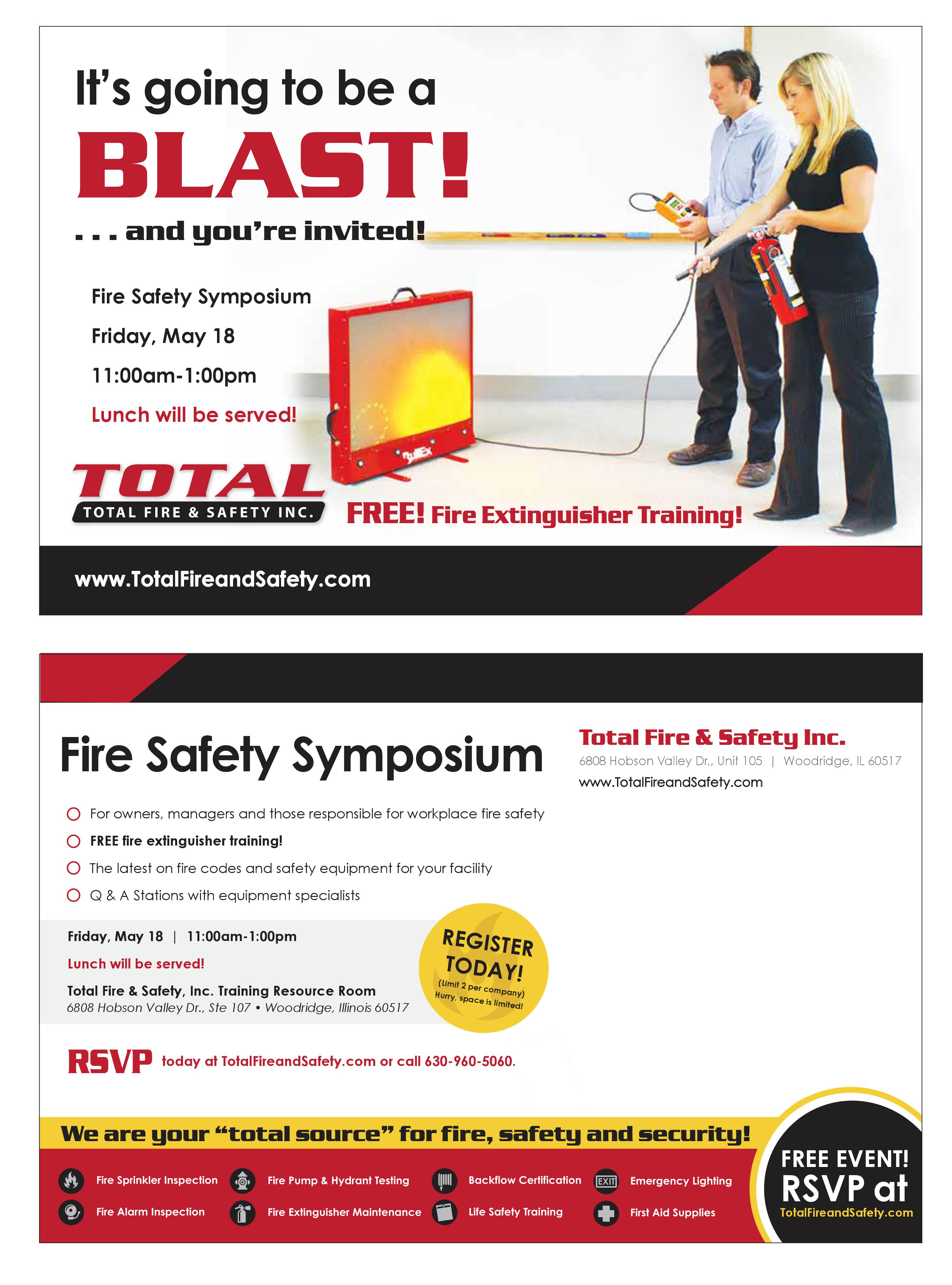
Category: Business Safety, Client Events, Fire Extinguishers, Fire Extinguishers, Fire News, Fire Safety Tags: commercial fire safety, employee training, fire and safety equipment, fire and safety solutions, Fire Extinguisher, fire safety, fireextinguisher, Fireextinguishertraining, Total Fire & Safety, Total Fire and Safety, training | Comments Off on Fire Safety Symposium
-
December 19, 2017 by Total Fire and Safety
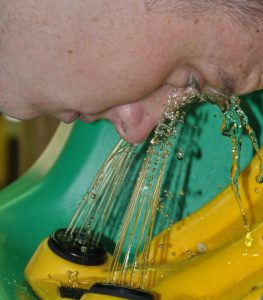 If you have hazardous chemicals onsite, you likely need an emergency eyewash station. One of the many vital services we provide at Total Fire and Safety is performing inspections on emergency showers and eye wash stations. Like any fire or safety equipment, routine inspections are a must to ensure your equipment will perform perfectly at a moment’s notice. In an emergency situation, nobody has the time troubleshoot an underperforming piece of equipment, let alone attempt to repair it. We’ve outlined the steps we take to ensure your eye wash station or emergency shower is ready in an emergency:
1. Ensure everything about the station’s location is correct. We first make sure the station is in an area it is needed. A working emergency eye wash station is of no use if it is not accessible to those who may need it. While showers tend to be fixed structures, eye wash stations can be either fixed or mobile. We also make sure the station is unobstructed and away from any source of debris or hazardous spray, which could compromise its usefulness.
2. Next, we inspect the exterior. We visually check every part of the station for any signs of damage, such as leaks, cracks, or other signs. Then, we check that all the hardware is intact and correctly in place, such as the caps, valves, and pull rods for showers. We then verify everything is at the correct height and that all signage is in its proper place before moving on to the next step.
3. After the visual inspection, we test the operation. For every eye wash station, we check the flow of water by gauging its height, volume, and response time from the moment of activation. For showers, we verify the water flows properly and onto the correct area.
4. For portable units, we empty and replace the water. This is to ensure the water in the reservoir is not only full, but clean and fresh. This step is also taken so that we can rinse out the inside as well as check for foreign debris or contaminants which could compromise the integrity of the eye wash station.
5. Finally, we clean everything and document the inspection. This entails wiping everything down with a rag and cleaning solution. Once this is done, we apply the inspection tag to the station to communicate to others when the inspection took place and what was performed. We also keep our own records of the inspection by filling out detailed information in an eyewash report.
In any facility that may contain hazardous substances, you may find an emergency shower or eye wash station idly waiting until needed. These units are not given much thought, but anyone who has ever used one in an emergency situation will vouch for its importance to stay in proper working order. If you have any questions or concerns about your emergency eye wash station or shower, or about the readiness of any of your fire safety equipment, please contact us.
Category: First Aid, Health and Safety, NFPA Compliance, Total Fire and Safety, Uncategorized Tags: fire and safety equipment, first aid, first aid supplies, Health and Safety, Total Fire & Safety | Comments Off on Are Your Emergency Eye Wash Stations Ready for Action?
|
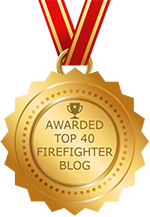
|
|
|
|
|
|

 Facebook
Facebook
 Instagram
Instagram
 LinkedIn
LinkedIn









